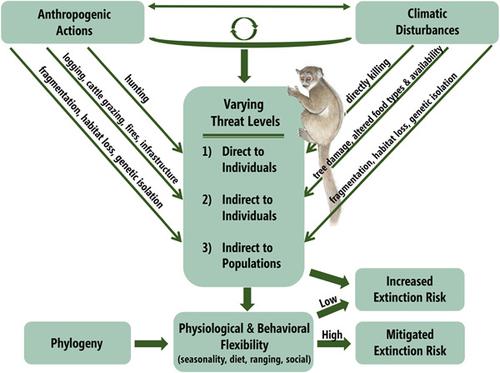当前位置:
X-MOL 学术
›
Am. J. Primatol.
›
论文详情
Our official English website, www.x-mol.net, welcomes your feedback! (Note: you will need to create a separate account there.)
The influence of seasonality, anthropogenic disturbances, and cyclonic activity on the behavior of northern sportive lemurs (Lepilemur septentrionalis) at Montagne des Français, Madagascar
American Journal of Primatology ( IF 2.4 ) Pub Date : 2021-10-22 , DOI: 10.1002/ajp.23333 Mary P Dinsmore 1, 2 , Karen B Strier 3 , Edward E Louis 4, 5
American Journal of Primatology ( IF 2.4 ) Pub Date : 2021-10-22 , DOI: 10.1002/ajp.23333 Mary P Dinsmore 1, 2 , Karen B Strier 3 , Edward E Louis 4, 5
Affiliation

|
Anthropogenic tropical deforestation and degradation imminently threaten primates today. Primates living in these disturbed habitats may also be subjected to increasingly severe tropical storms such as cyclones or hurricanes. These disturbances pose an immediate risk to their livelihood and can dramatically alter their habitats, in turn potentially shifting behavioral patterns. We had the unique opportunity to study the effects of seasonality, anthropogenic disturbances, and the immediate effects of a cyclone on the behavior of the critically endangered northern sportive lemur (NSL) in an anthropogenically disturbed forest in Madagascar. Cyclone Enawo made landfall on March 7, 2017 in northeast Madagascar with sustained wind speeds of 230 km/h. We collected behavioral data on nine individual NSLs during both wet and dry seasons, before and after Cyclone Enawo, and in areas of differing human activity, using scan sampling at 5-min intervals. We ran generalized linear mixed models to test the effects of seasonality and disturbances on behavior. We found that NSLs spent more time feeding in dry months compared with wet (Z = −4.21, p < 0.001). More specifically, they spent more time-consuming leaves and vine species in the dry season (Z = −2.26, p = 0.02; Z = −2.3; p = 0.02). We also found that NSLs were observed at lower heights in trees after the cyclone (Z = −2.45; p = 0.016) and spent more time in the interior portions of trees (Z = 3.44; p < 0.001), perhaps due to extensive limb damage of emergent trees documented after the cyclone. Our analyses show that seasonality affected most aspects of NSL behavior, followed by the effects of Cyclone Enawo, with anthropogenic disturbances having little effect. Our data suggest that the behavioral flexibility of NSLs in response to predictable seasonality may enable them to respond similarly to stochastic climatic disturbances. However, their generalist diet may allow them to persist in anthropogenically disturbed landscapes without the need to greatly alter their behavior.
中文翻译:

季节性、人为干扰和气旋活动对马达加斯加 Montagne des Français 北部运动狐猴 (Lepilemur septentrionalis) 行为的影响
今天,人为的热带森林砍伐和退化迫在眉睫地威胁着灵长类动物。生活在这些受干扰栖息地的灵长类动物也可能遭受越来越严重的热带风暴,例如旋风或飓风。这些干扰对他们的生计构成直接风险,并可能极大地改变他们的栖息地,进而可能改变行为模式。我们有独特的机会研究季节性、人为干扰以及旋风对马达加斯加人为干扰森林中极度濒危的北方运动狐猴 (NSL) 行为的直接影响。气旋埃纳沃于 2017 年 3 月 7 日在马达加斯加东北部登陆,持续风速为 230 公里/小时。我们在雨季和旱季收集了九个人 NSL 的行为数据,在飓风 Enawo 之前和之后,以及在不同人类活动的区域,以 5 分钟的间隔使用扫描采样。我们运行广义线性混合模型来测试季节性和干扰对行为的影响。我们发现,NSLs 在干燥月份比潮湿月份花费更多的时间进食(Z = -4.21,p < 0.001)。更具体地说,他们在旱季花费了更多耗时的树叶和藤本植物(Z = -2.26,p = 0.02;Z = -2.3;p = 0.02)。我们还发现,在飓风过后,在树木的较低高度观察到 NSL(Z = -2.45;p = 0.016),并且在树木内部花费了更多时间(Z = 3.44;p < 0.001),可能是由于旋风后记录的紧急树木的广泛肢体损伤。我们的分析表明,季节性影响了 NSL 行为的大部分方面,其次是飓风 Enawo 的影响,人为干扰几乎没有影响。我们的数据表明,NSL 响应可预测的季节性的行为灵活性可能使它们能够类似地响应随机气候干扰。然而,他们的通才饮食可能使他们能够在人为干扰的景观中坚持下去,而无需大大改变他们的行为。
更新日期:2021-11-29
中文翻译:

季节性、人为干扰和气旋活动对马达加斯加 Montagne des Français 北部运动狐猴 (Lepilemur septentrionalis) 行为的影响
今天,人为的热带森林砍伐和退化迫在眉睫地威胁着灵长类动物。生活在这些受干扰栖息地的灵长类动物也可能遭受越来越严重的热带风暴,例如旋风或飓风。这些干扰对他们的生计构成直接风险,并可能极大地改变他们的栖息地,进而可能改变行为模式。我们有独特的机会研究季节性、人为干扰以及旋风对马达加斯加人为干扰森林中极度濒危的北方运动狐猴 (NSL) 行为的直接影响。气旋埃纳沃于 2017 年 3 月 7 日在马达加斯加东北部登陆,持续风速为 230 公里/小时。我们在雨季和旱季收集了九个人 NSL 的行为数据,在飓风 Enawo 之前和之后,以及在不同人类活动的区域,以 5 分钟的间隔使用扫描采样。我们运行广义线性混合模型来测试季节性和干扰对行为的影响。我们发现,NSLs 在干燥月份比潮湿月份花费更多的时间进食(Z = -4.21,p < 0.001)。更具体地说,他们在旱季花费了更多耗时的树叶和藤本植物(Z = -2.26,p = 0.02;Z = -2.3;p = 0.02)。我们还发现,在飓风过后,在树木的较低高度观察到 NSL(Z = -2.45;p = 0.016),并且在树木内部花费了更多时间(Z = 3.44;p < 0.001),可能是由于旋风后记录的紧急树木的广泛肢体损伤。我们的分析表明,季节性影响了 NSL 行为的大部分方面,其次是飓风 Enawo 的影响,人为干扰几乎没有影响。我们的数据表明,NSL 响应可预测的季节性的行为灵活性可能使它们能够类似地响应随机气候干扰。然而,他们的通才饮食可能使他们能够在人为干扰的景观中坚持下去,而无需大大改变他们的行为。



























 京公网安备 11010802027423号
京公网安备 11010802027423号